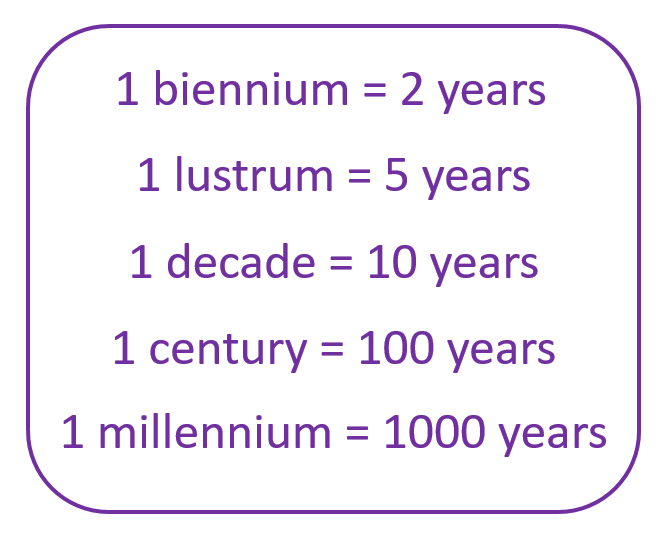In this post we’re going to look at measurements of time that refer to quantities of years: biennium, lustrum, decade, century, millenium
If you want to review previous posts on units of time, you can do so here:
- Learn how to measure time and the units associated
- Time: basic concepts to help learn how to tell the time
- Time measurements problems: simple and complex forms
Before you read on, the most important thing you need to understand is the following:

We’re going to practice these concepts using a few problems that you can find during your daily Smartick sessions. Let’s start!
Problem 1

To solve this problem, we have to remember that a century is 100 years, therefore 4 centuries are 4×100=400 years.
Knowing this, we just have to add these 400 years to the year in which the bottle was made, 2009.
Therefore 2009 + 400 = 2409
Answer: The bottle’s lifespan will end in 2409
Problem 2

To solve this problem, we need to subtract the dates.
2002 – 1997 = 5
The unit of time equivalent to 5 years is a lustrum.
Answer: A lustrum passed between both trips
Problem 3

The first thing we need to do to solve this problem is calculate the number of years that pass between 3655 B.C. and 2010.
To do this, we add 3655 and 2010. 3655 + 2010 = 5665
Now we need to break this length of time down into smaller units.
5000 years is 5 millennia
600 years is 6 centuries
60 years is 6 decades
5 years is a lustrum
Therefore, 5 millennia + 6 centuries + 6 decades + one lustrum
Answer: 5 millennia, 6 centuries, 6 decades and one lustrum had passed
Problem 4

To solve this problem, first we need to take into account that the rock is now 1/4 of its original size, which means that it has lost 3/4 of its size.
If 13 lustra pass for every quarter, we need to multiply this amount by 3. 3 x 13 = 39 lustra
Now we just need to multiply the 39 lustra by the 5 years that each lustrum contains:
39 x 5 = 195
Answer: It has been exposed to 195 years of erosion
I hope these exercises have helped you understand larger units of time. Remember, if you want to practice more of these problems and many others like how to calculate lcm, register with Smartick and do your session every day.
Learn More:
- Learn How to Solve a Time Word Problem
- Commutative Property in Multiplication and Addition
- Distributive Property in Geometry
- Problems with Fractions and How to Solve Them
- How to Solve Mass Conversion Problems








very educating
good to learn
I am here to learn
Love it!
I love this lesson tell me more about it
Hi Temilola,
Thank you very much for your comment.
If you want to learn more content like this and practice elementary school math, just sign up at Smartick. You have a free trial period with no strings attached.
If you have any additional questions or doubts you can write to my colleagues of the pedagogical team at [email protected].
Best regards!
Because there is no year 0 in the Gregorian calendar (the calendar used in most parts of the world), the number of years separating 3655 BC and 2010 AD is NOT 2010 – (-3655) = 2010 + 3655 = 5665 years but rather 5665 – 1 = 5664 years.
To see this quickly, it may help to realize that without a year 0, any date (for instance, January 24) of the year 1 BC is one year, NOT 1 – (-1) = 2 years, prior to the same date of the year 1 AD.
It seems people like to place the blame for the omission of a year 0 on Bede, an English monk, who was one of the greatest scholars of the Early Middle Ages. IMHO, this is hardly fair, especially since the first use of the number zero did not take place in England until the year 1598, some 863 years after Bede’s death.
Hi
Hi, I love this page it is amazing and really helpful for my students.
This is so helpful and educative. Thanks for the thought!
Thanks
very helpful
VERY HELPFUL AND EDUCATIVE. INDEED
COOL!!!!!!